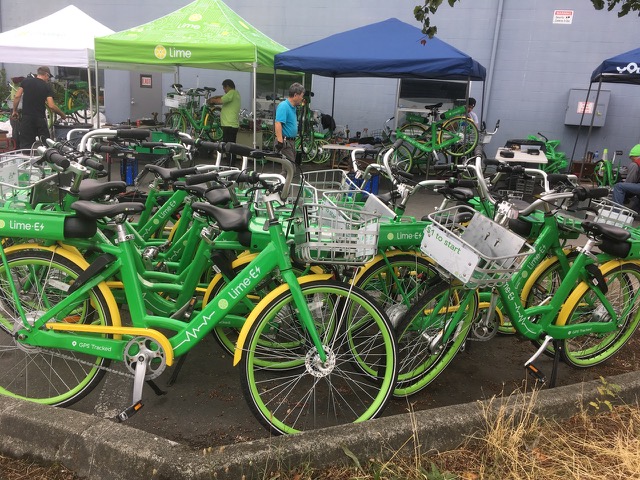
Six days after I stumbled upon hundreds of bikes Lime bikes crammed in a Ballard warehouse parking lot and onto the sidewalk I went back to check again and was met by frosty stares when my iPhone camera came out: “Can I help you?” “Yeah, what are you up to?” “I’ll have to get my manager.”
I prevailed on one point. “We’d rather you didn’t take pictures; this is private property.” “I’m on a public sidewalk.” And so on. I got one good answer: “What are you fixing?” “Bikes.”
That’s exactly what they were doing. Maybe ten mechanics wielding pliers, sitting on the ground with bike parts on their knees or hunched over bike skeletons clamped to stands. I counted about 60 bikes, some probably incoming, some piled behind a dumpster probably ready to go. Everywhere lots of pieces and parts.
Not a neighborhood Fix-Your-Bike-Day, but a busy shop still displaced from its darkened warehouse. So why outside? A post in My Ballard reported on a fire in the warehouse on August 14. The Fire Department said the fire was a result of first one, then more bike battery packs igniting. Seattle City Light cut power to the building to prevent electrical risk to fire fighters from working amidst sprinkler flows mixing with the battery acid. As my earlier post reported, power was still out in the warehouse days later.
To have all that bike mending outside the warehouse in plain view from the sidewalk throws an interesting light on last week’s SDOT’s quarterly bike share report. SDOT field audits for the second quarter of 2019 found safety maintenance issues on 2% of Lime Bikes and a further 5.6% of Lime bikes not meeting SDOT’s standards of good working order. That would extrapolate to about 200 bikes if Lime has 2,500 bikes in service in Seattle. Maybe some of those bikes, or ones like them, were now these bikes in Ballard, getting first aid or major surgery from the bike medics under the pop-up tents in the parking lot. A closer look at the bikes themselves might reveal a lot about how fate and hard use treat a bike-share bike in Seattle.
More intriguing, however, are some other dots, maybe connected, maybe not. The same night the bike batteries ignited in the Lime Bike Ballard warehouse, a passerby video caught some spectacular Lime Bike battery pyrotechnics on the UW campus, sparking reports of Seattle Fire Department concerns about increased fires from proliferation of all sorts of devices, from smart phones to hoverboards, using lithium-ion batteries. A call to the Lime Bike spokesperson whose number I was given to get answers to my questions has not been returned.
E-bike battery fire news has been a bit of a rage lately, not just from Seattle, but from the East Coast and San Francisco. But most of the battery-fire news is currently coming from the e-scooter world that Seattle has not yet entered. Last fall Lime took 2,000 e-scooters out of service in an “abundance of caution” over fire risks from a potential battery manufacturing defect, according to the Washington Post. Meanwhile, only ten days ago e-scooter competitor Skip’s scooters were returned to Washington D.C. streets after a fire-related fleet grounding last May.
All of which prompts the question: are these batteries ready for prime time, particularly if they get banged up by careless riders or vandalized by the angry or the mischievous?
This is no idle question. SDOT just announced that its e-scooter program will finally roll out next spring after six-months due-diligence. SDOT hasn’t commented on the e-bike battery fires in context of its future e-scooter program, but the issue must be on their minds: “[SDOT Program Manager Joel] Miller says SDOT wants to see where battery technology evolves over the next six months.’”
Evolves indeed. Sounds as if due diligence should be the order of the day.
Image: Doug MacDonald
Discover more from Post Alley
Subscribe to get the latest posts sent to your email.

About the coming of e-scooters (which I tried out myself within Belle Isle Park in Detroit, Michigan a few weeks ago, a city where several brands of them are available on sidewalks downtown), note this academic journal article describing that in Munich, Germany, a small sample of residents using electric scooters found that “a majority of daily trips is suitable for e-scooters and charging infrastructure is sufficient for this kind of vehicle, while subjective safety, weather conditions, and baggage capacity are restricting attributes.”
“Usage of e-Scooters in Urban Environments” by Cornelius Hardt and Klaus Bogenberger in
Transportation Research Procedia, Volume 37, 2019, Pages 155-16
Full text at https://www.sciencedirect.com/science/article/pii/S2352146518305933
e-Scooters, electric bikes, electric skateboards…..the cycling ethos that was supposed to get us out of our cars, get us some exercise and make us healthier has devolved into just another commercial enterprise that allows us to be as lazy as ever. Why is it that technology so often seems to lead us downhill not up?
Here’s a KOMO story exploring the illegal parking and battery-fire aspects of these bikes. https://komonews.com/news/local/improper-parking-fires-plague-bikeshare-program-in-seattle